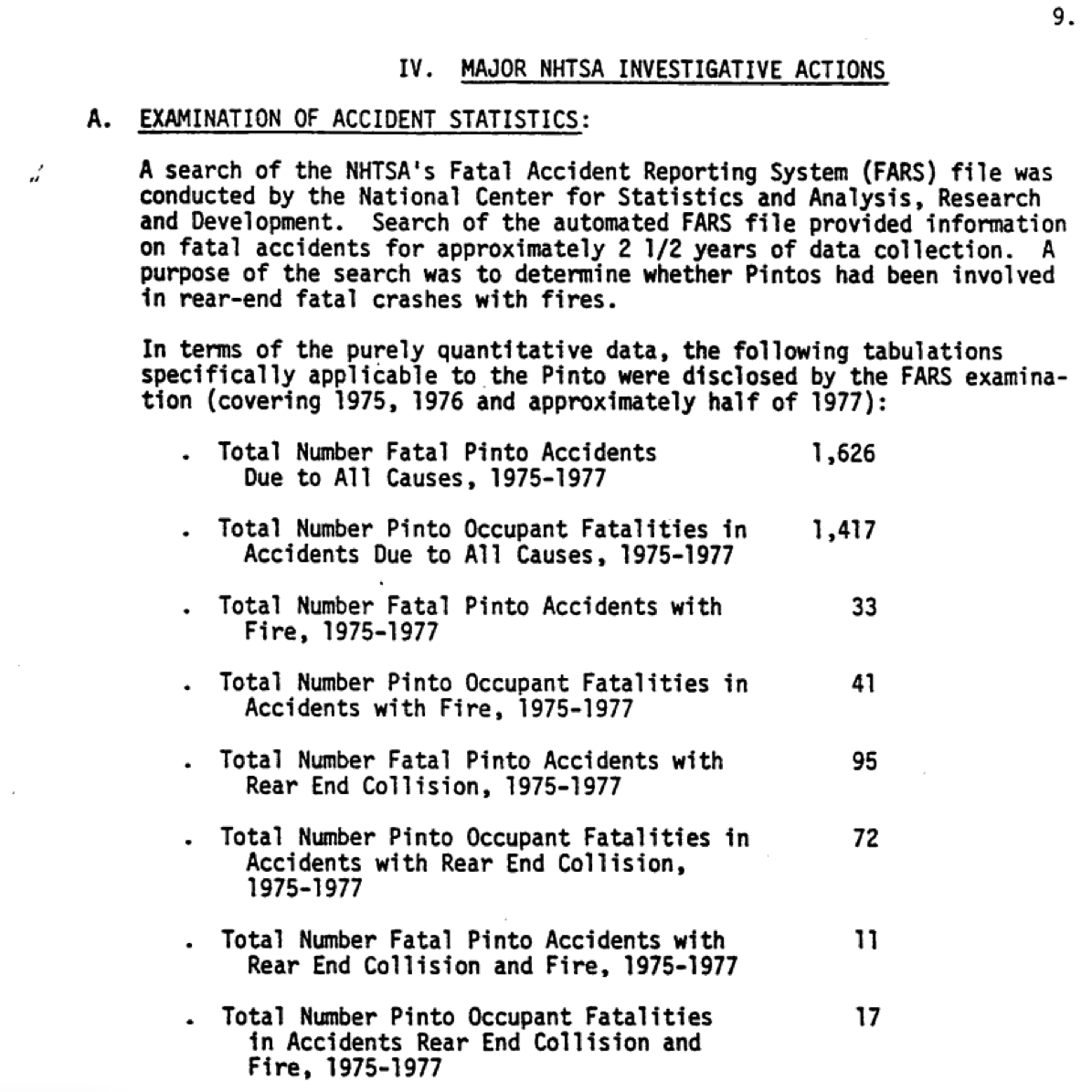especially if one paints "die nazi scum" on the windshield
Tesla
The Tesla community of Lemmy
Related communities:
- [email protected]
- [email protected]
- [email protected]
- [email protected]
- [email protected]
- [email protected]
- [email protected]
a fatality rate of 14.5 percent per 100,000 units.
Tell me you don't understand statistics without telling me you don't understand statistics.
It's clear they meant "14.5 per 100,000 units" because later they call that "17 times" the Ford Pinto's fatality rate of "0.85 per 100,000 units". 14.5 divided by 0.85 is 17.06, so very close to "17 times."
But that "percent" is just randomly thrown in there and is largely meaningless.
(Taking it as literally as it could possibly be taken, one could say it meant "0.145 per 100,000 units". But again, from the context in the rest of the article, it's clear that's not what they meant as that's not "17 times" 0.85.)
Swastitruck
The podcast You're Wrong About did an episode about the Pinto. Spoiler alert: wasn't that unsafe. If you listen to podcasts, you know how to find the episode. If not, here's the YouTube mirror https://youtu.be/52pPcMwM6Wc
the pinto data is quite remarkably cherry picked (1626 deaths in 2.5 years):

(sauce: https://www.autosafety.org/wp-content/uploads/import/ODIPinto.pdf Page 9.)
They look like robot shit
the approximately 34,000 Cybertrucks on the roads had five fire fatalities
-
They sold millions of Pintos. Sample size is important.
-
They included the guy who shot himself and then blew up the truck. That had nothing to do with the truck. That one death made up 20% of their fatalities.
-
The other 3 victims were all in the same vehicle, in the same crash, which means these 4 deaths were comprised of 2 incidents. Name another production car that hasn't had at least 2 collisions that resulted in a fire fatality.
Bad journalism is bad.
Ok, so instead of the Cybertruck being 17 times deadlier than the Ford Pinto, it's only 13.6 times deadlier. Wow, thanks for pointing this out.
See 1. I'd venture a guess that the first 34k Pintos had a much higher fatality rate than the >1M ones.
Source?
Source https://www.autosafety.org/wp-content/uploads/import/ODIPinto.pdf Page 9.
@[email protected] is absolutely correct
Can you point out specifically where it says that the first 34k pintos had a higher fatality rate? I read page 9 and didn't see it.
Pintos had an over two orders of magnitude higher mortality rate then the numbers used in the original “analysis“. The rest of this is moot.
It's reported as the rate per 100,000 units. So that's accounted for.
Bad commenting is bad.
- The total is 4. Thats the definition of a small sample.
I'd suggest you familiarize yourself with the concept of sample sizes.
So, Wikipedia says the Ford Pinto sold 3,173,491 units. This article says there were 27 Ford Pinto fatalities. The article also says the Cybertruck sold 34,000 units and there have been 5 fatalities.
Your point 2 aside, you're not trying to argue that (5/34,000) / (27/3,173,491) isn't approximately 17, right?
(Again, point 2 aside) is your point that 5 deaths (or rather 4 deaths if you don't count the guy from point 2) out of 34,000 units isn't a big enough sample size to draw conclusions and that you think it's likely that as more units are sold, the rate won't stay that high and over time the data will average out to a fatality rate less than that of the Ford Pinto?
One more question if I may. Are you a fan of Tesla?
Dude. I've taught statistics. I don't think you understand what you're arguing here. lol.
Why don't you bring me up to speed instead of levying personal attacks and then disappearing?
I get paid to teach stats. So not my job here. But let me use common sense and see if that works.
Is a comparison valid? Of course it is. Connecticut has a population of about 3.5 million. Torrington CT has a population of around 35,000. Are you telling me that you can't compare death rates in Torrington vs. the rest of Connecticut because of "statistics"?
You can compare whatever you want. But there are good comparisons and there are bad comparisons, and this is the latter.
Also we're talking about cars that roll off an assembly line, not people. If the death rate is higher in people, do you blame the people? Another bad comparison.
What are you even talking about? Failure rates in manufacturing are governed by the same statistics rules as human errors or deaths for sufficiently large n. And 35,000 is sufficiently large n .
It's a valid comparison and statistically sound.
Jesus Christ. You really need this spelled out, don't you?
-
Machines coming off an assembly line are almost completely identical, which you cannot say for humans.
-
We can fix errors in vehicle manufacturing very easily, which you also cannot say for humans.
-
You're comparing death rates in humans across locales, which is looking for environmental variables and not biological ones. When comparing death rates among different vehicles, you're looking for manufacturing errors.
This is a bad comparison and statistically insignificant.
If machines coming off an assembly line are virtually identical, then a smaller sample size can be used due to reduced variation. Larger samples are required to control for variation.
I think you guys are just blowing smoke for kicks at this point. Your stats reasoning doesn't display even a superficial understanding.
You're just intentionally ignoring #2, ignoring the fact that we were comparing machines vs. humans, and arguing in bad faith because you know you're wrong, and you're bad at your job and trying to save face. We're done here.